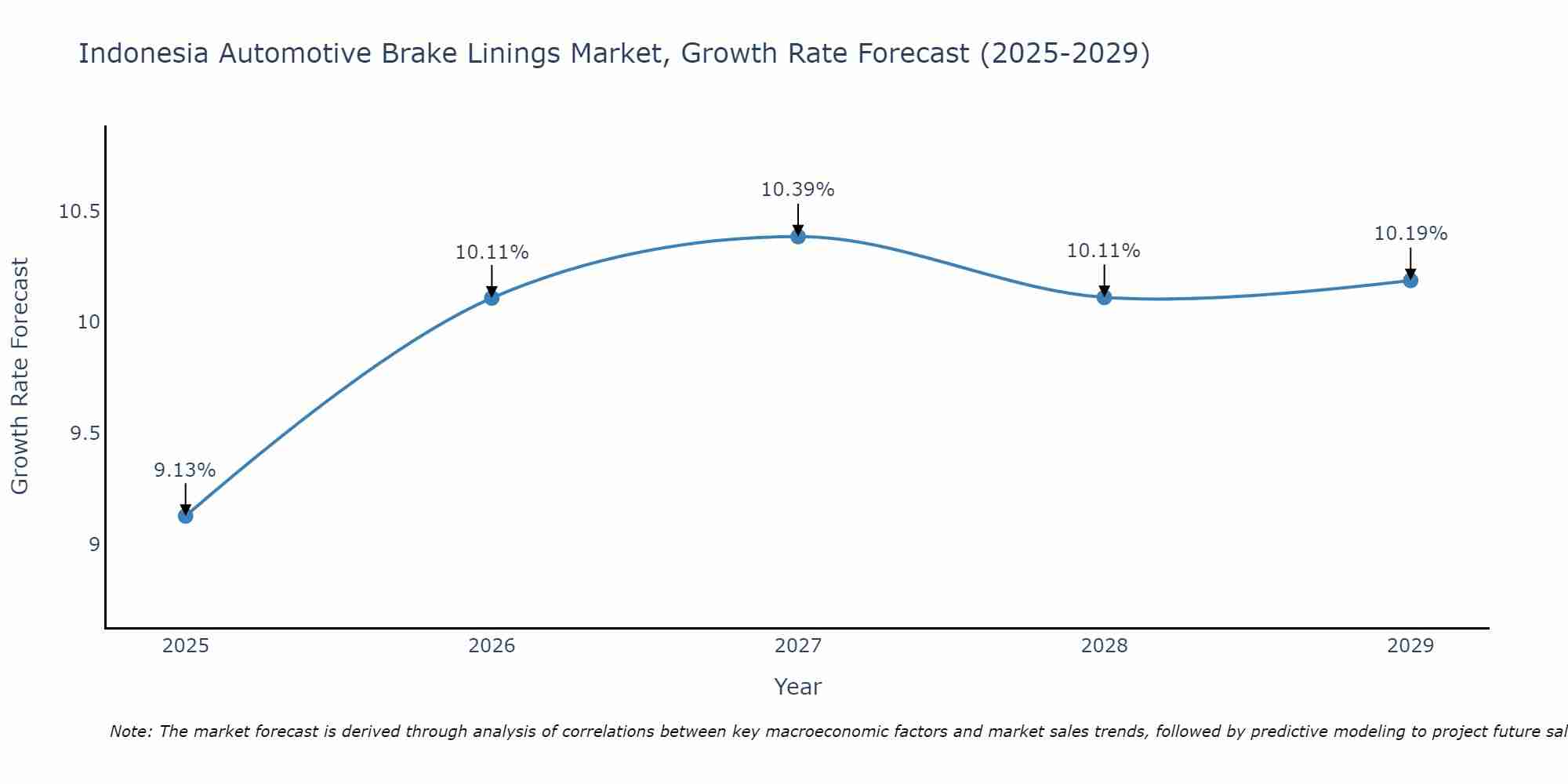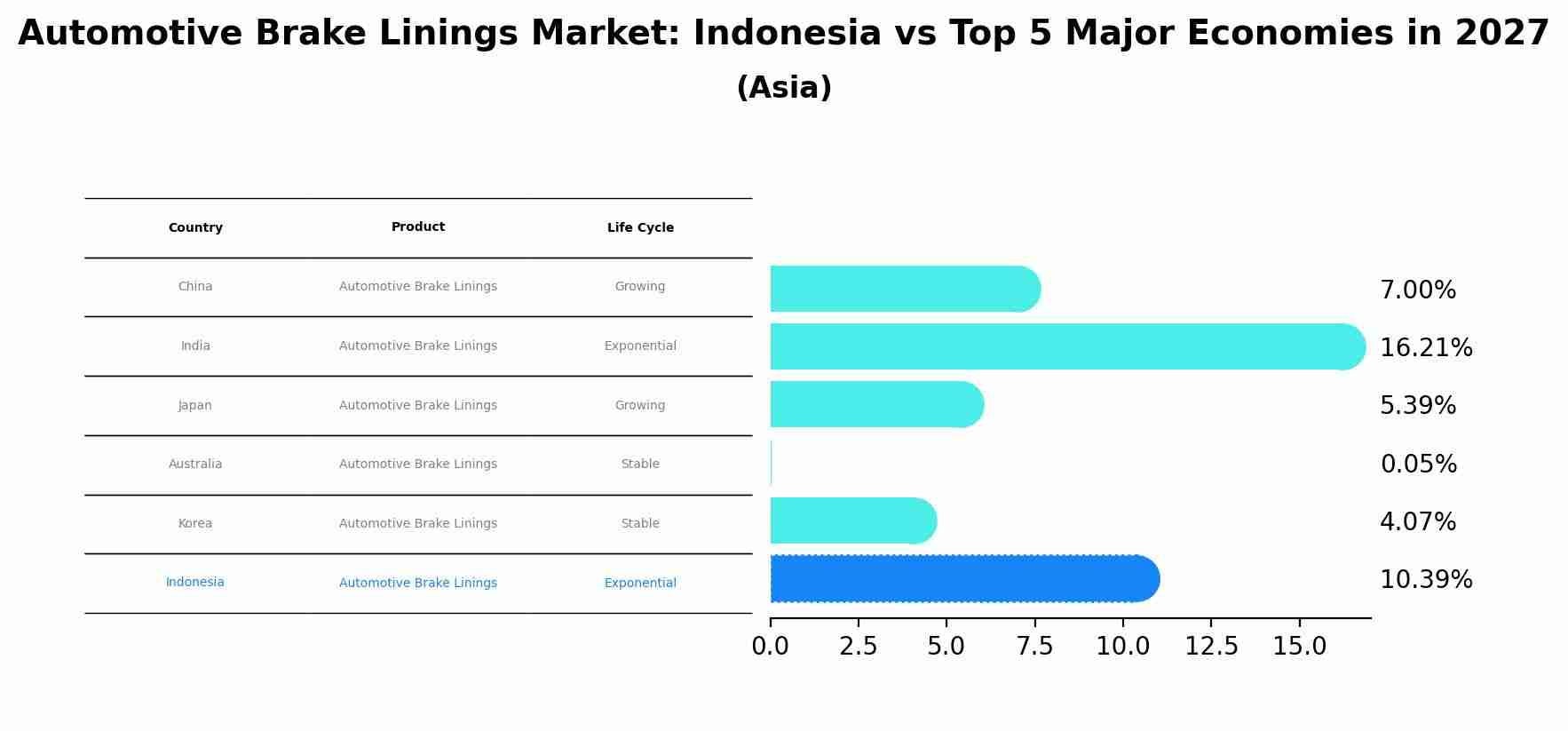Indonesia Automotive Brake Linings Market (2025-2031) Outlook | Revenue, Analysis, Industry, Trends, Growth, Share, Companies, Value, Forecast & Size
| Product Code: ETC273568 | Publication Date: Aug 2023 | Updated Date: Aug 2025 | Product Type: Market Research Report | |
| Publisher: 6Wresearch | No. of Pages: 75 | No. of Figures: 35 | No. of Tables: 20 | |
Indonesia Automotive Brake Linings Market Size Growth Rate
The Indonesia Automotive Brake Linings Market is projected to witness mixed growth rate patterns during 2025 to 2029. Growth accelerates to 10.39% in 2027, following an initial rate of 9.13%, before easing to 10.19% at the end of the period.

Automotive Brake Linings Market: Indonesia vs Top 5 Major Economies in 2027 (Asia)
By 2027, Indonesia's Automotive Brake Linings market is forecasted to achieve a high growth rate of 10.39%, with China leading the Asia region, followed by India, Japan, Australia and South Korea.

Indonesia Automotive Brake Linings Market Synopsis
The Indonesia automotive brake linings market is estimated to reach a value of USD 59 million in 2025, growing at a CAGR of 7. 8% during the forecast period. Increasing vehicle production coupled with rising safety concerns among consumers are the major factors driving the growth of this industry over the forecast period. Furthermore, technological advancements such as improved friction materials used for better performance also contribute significantly towards bolstering product demand across various segments within this industry landscape.
Drivers of the Market
The overall growth of the automotive industry in Indonesia, including passenger cars and commercial vehicles, is a significant driver for the brake linings market. Increased vehicle production and sales lead to higher demand for brake components. Government regulations and safety standards that mandate the use of high-quality brake systems contribute to the demand for reliable brake linings. Manufacturers may need to upgrade and improve their braking systems to meet these standards. As urban areas expand and infrastructure projects increase, the demand for commercial vehicles, such as buses and trucks, also rises. These vehicles require efficient braking systems, boosting the market for brake linings.
Challenges of the Market
Challenges could involve meeting stricter regulations for brake components, developing friction materials that are effective and long-lasting, optimizing manufacturing processes for cost-efficiency, and staying competitive in a rapidly evolving automotive industry.
COVID-19 Impact on the Market
The pandemic disrupted global and domestic supply chains, leading to shortages of raw materials and components required for manufacturing brake linings and brake pads. Factory closures, transportation restrictions, and labor shortages contributed to these disruptions. Lockdowns and restrictions on non-essential businesses led to production slowdowns and, in some cases, temporary factory closures. Reduced workforce and operational challenges hindered the manufacturing process. With economic uncertainties and restrictions on movement, consumer spending on big-ticket items like automobiles declined. As a result, automotive manufacturers reduced production, leading to lower demand for brake linings and brake pads.
Key Highlights of the Report:
- Indonesia Automotive Brake Linings Market Outlook
- Market Size of Indonesia Automotive Brake Linings Market, 2024
- Forecast of Indonesia Automotive Brake Linings Market, 2031
- Historical Data and Forecast of Indonesia Automotive Brake Linings Revenues & Volume for the Period 2021-2031
- Indonesia Automotive Brake Linings Market Trend Evolution
- Indonesia Automotive Brake Linings Market Drivers and Challenges
- Indonesia Automotive Brake Linings Price Trends
- Indonesia Automotive Brake Linings Porter's Five Forces
- Indonesia Automotive Brake Linings Industry Life Cycle
- Historical Data and Forecast of Indonesia Automotive Brake Linings Market Revenues & Volume By Material for the Period 2021-2031
- Historical Data and Forecast of Indonesia Automotive Brake Linings Market Revenues & Volume By Non Asbestos for the Period 2021-2031
- Historical Data and Forecast of Indonesia Automotive Brake Linings Market Revenues & Volume By Semi Asbestos for the Period 2021-2031
- Historical Data and Forecast of Indonesia Automotive Brake Linings Market Revenues & Volume By Ceramic Friction Brake Lining for the Period 2021-2031
- Historical Data and Forecast of Indonesia Automotive Brake Linings Market Revenues & Volume By Vehicle Type for the Period 2021-2031
- Historical Data and Forecast of Indonesia Automotive Brake Linings Market Revenues & Volume By Passenger for the Period 2021-2031
- Historical Data and Forecast of Indonesia Automotive Brake Linings Market Revenues & Volume By Commercial for the Period 2021-2031
- Historical Data and Forecast of Indonesia Automotive Brake Linings Market Revenues & Volume By Sales Channel for the Period 2021-2031
- Historical Data and Forecast of Indonesia Automotive Brake Linings Market Revenues & Volume By OEM for the Period 2021-2031
- Historical Data and Forecast of Indonesia Automotive Brake Linings Market Revenues & Volume By Aftermarket for the Period 2021-2031
- Indonesia Automotive Brake Linings Import Export Trade Statistics
- Market Opportunity Assessment By Material
- Market Opportunity Assessment By Vehicle Type
- Market Opportunity Assessment By Sales Channel
- Indonesia Automotive Brake Linings Top Companies Market Share
- Indonesia Automotive Brake Linings Competitive Benchmarking By Technical and Operational Parameters
- Indonesia Automotive Brake Linings Company Profiles
- Indonesia Automotive Brake Linings Key Strategic Recommendations
Frequently Asked Questions About the Market Study (FAQs):
1 Executive Summary |
2 Introduction |
2.1 Key Highlights of the Report |
2.2 Report Description |
2.3 Market Scope & Segmentation |
2.4 Research Methodology |
2.5 Assumptions |
3 Indonesia Automotive Brake Linings Market Overview |
3.1 Indonesia Country Macro Economic Indicators |
3.2 Indonesia Automotive Brake Linings Market Revenues & Volume, 2021 & 2031F |
3.3 Indonesia Automotive Brake Linings Market - Industry Life Cycle |
3.4 Indonesia Automotive Brake Linings Market - Porter's Five Forces |
3.5 Indonesia Automotive Brake Linings Market Revenues & Volume Share, By Material, 2021 & 2031F |
3.6 Indonesia Automotive Brake Linings Market Revenues & Volume Share, By Vehicle Type, 2021 & 2031F |
3.7 Indonesia Automotive Brake Linings Market Revenues & Volume Share, By Sales Channel, 2021 & 2031F |
4 Indonesia Automotive Brake Linings Market Dynamics |
4.1 Impact Analysis |
4.2 Market Drivers |
4.2.1 Increasing demand for automobiles in Indonesia |
4.2.2 Growth of transportation and logistics sector |
4.2.3 Stringent regulations on vehicle safety standards |
4.3 Market Restraints |
4.3.1 Price volatility of raw materials like asbestos and metals |
4.3.2 Competition from alternative braking technologies |
4.3.3 Economic fluctuations impacting consumer purchasing power |
5 Indonesia Automotive Brake Linings Market Trends |
6 Indonesia Automotive Brake Linings Market, By Types |
6.1 Indonesia Automotive Brake Linings Market, By Material |
6.1.1 Overview and Analysis |
6.1.2 Indonesia Automotive Brake Linings Market Revenues & Volume, By Material, 2021-2031F |
6.1.3 Indonesia Automotive Brake Linings Market Revenues & Volume, By Non Asbestos, 2021-2031F |
6.1.4 Indonesia Automotive Brake Linings Market Revenues & Volume, By Semi Asbestos, 2021-2031F |
6.1.5 Indonesia Automotive Brake Linings Market Revenues & Volume, By Ceramic Friction Brake Lining, 2021-2031F |
6.2 Indonesia Automotive Brake Linings Market, By Vehicle Type |
6.2.1 Overview and Analysis |
6.2.2 Indonesia Automotive Brake Linings Market Revenues & Volume, By Passenger, 2021-2031F |
6.2.3 Indonesia Automotive Brake Linings Market Revenues & Volume, By Commercial, 2021-2031F |
6.3 Indonesia Automotive Brake Linings Market, By Sales Channel |
6.3.1 Overview and Analysis |
6.3.2 Indonesia Automotive Brake Linings Market Revenues & Volume, By OEM, 2021-2031F |
6.3.3 Indonesia Automotive Brake Linings Market Revenues & Volume, By Aftermarket, 2021-2031F |
7 Indonesia Automotive Brake Linings Market Import-Export Trade Statistics |
7.1 Indonesia Automotive Brake Linings Market Export to Major Countries |
7.2 Indonesia Automotive Brake Linings Market Imports from Major Countries |
8 Indonesia Automotive Brake Linings Market Key Performance Indicators |
8.1 Percentage of vehicles equipped with brake linings meeting safety standards |
8.2 Adoption rate of advanced brake lining technologies in the market |
8.3 Rate of compliance with government regulations on brake lining quality and performance |
9 Indonesia Automotive Brake Linings Market - Opportunity Assessment |
9.1 Indonesia Automotive Brake Linings Market Opportunity Assessment, By Material, 2021 & 2031F |
9.2 Indonesia Automotive Brake Linings Market Opportunity Assessment, By Vehicle Type, 2021 & 2031F |
9.3 Indonesia Automotive Brake Linings Market Opportunity Assessment, By Sales Channel, 2021 & 2031F |
10 Indonesia Automotive Brake Linings Market - Competitive Landscape |
10.1 Indonesia Automotive Brake Linings Market Revenue Share, By Companies, 2024 |
10.2 Indonesia Automotive Brake Linings Market Competitive Benchmarking, By Operating and Technical Parameters |
11 Company Profiles |
12 Recommendations |
13 Disclaimer |
- Single User License$ 1,995
- Department License$ 2,400
- Site License$ 3,120
- Global License$ 3,795
Search
Related Reports
- UAE Building Thermal Insulation Market Outlook (2025-2031) | Revenue, Companies, Share, Trends, Growth, Size, Forecast, Industry, Analysis & Value
- Portugal Electronic Document Management Market (2025-2031) | Strategy, Consumer Insights, Analysis, Investment Trends, Opportunities, Growth, Size, Share, Industry, Revenue, Segments, Value, Segmentation, Supply, Forecast, Restraints, Outlook, Competition, Drivers, Trends, Demand, Pricing Analysis, Competitive, Strategic Insights, Companies, Challenges
- France Electronic Document Management Market (2025-2031) | Strategy, Consumer Insights, Analysis, Investment Trends, Opportunities, Growth, Size, Share, Industry, Revenue, Segments, Value, Segmentation, Supply, Forecast, Restraints, Outlook, Competition, Drivers, Trends, Demand, Pricing Analysis, Competitive, Strategic Insights, Companies, Challenges
- Portugal Occupational Health & Safety Services Market (2025-2031) | Strategy, Consumer Insights, Analysis, Investment Trends, Opportunities, Growth, Size, Share, Industry, Revenue, Segments, Value, Segmentation, Supply, Forecast, Restraints, Outlook, Competition, Drivers, Trends, Demand, Pricing Analysis, Competitive, Strategic Insights, Companies, Challenges
- Netherlands Occupational Health and Safety Services Market (2025-2031) | Strategy, Consumer Insights, Analysis, Investment Trends, Opportunities, Growth, Size, Share, Industry, Revenue, Segments, Value, Segmentation, Supply, Forecast, Restraints, Outlook, Competition, Drivers, Trends, Demand, Pricing Analysis, Competitive, Strategic Insights, Companies, Challenges
- Belgium and Luxembourg Facility Management Market (2025-2031) | Strategy, Consumer Insights, Analysis, Investment Trends, Opportunities, Growth, Size, Share, Industry, Revenue, Segments, Value, Segmentation, Supply, Forecast, Restraints, Outlook, Competition, Drivers, Trends, Demand, Pricing Analysis, Competitive, Strategic Insights, Companies, Challenges
- Russia Women Intimate Apparel Market (2025-2031) | Strategy, Consumer Insights, Analysis, Investment Trends, Opportunities, Growth, Size, Share, Industry, Revenue, Segments, Value, Segmentation, Supply, Forecast, Restraints, Outlook, Competition, Drivers, Trends, Demand, Pricing Analysis, Competitive, Strategic Insights, Companies, Challenges
- Africa Chocolate Market (2025-2031) | Size, Share, Trends, Growth, Revenue, Analysis, Forecast, industry & Outlook
- Global Hydroxychloroquine And Chloroquine Market (2025-2031) | Industry, Trends, Size, Outlook, Growth, Value, Companies, Revenue, Analysis, Share, Forecast
- Saudi Arabia Plant Maintenance Market (2025-2031) | Industry, Size, Growth, Revenue, Value, Companies, Forecast, Analysis, Share & Trends
Industry Events and Analyst Meet
Our Clients
Whitepaper
- Middle East & Africa Commercial Security Market Click here to view more.
- Middle East & Africa Fire Safety Systems & Equipment Market Click here to view more.
- GCC Drone Market Click here to view more.
- Middle East Lighting Fixture Market Click here to view more.
- GCC Physical & Perimeter Security Market Click here to view more.
6WResearch In News
- Doha a strategic location for EV manufacturing hub: IPA Qatar
- Demand for luxury TVs surging in the GCC, says Samsung
- Empowering Growth: The Thriving Journey of Bangladesh’s Cable Industry
- Demand for luxury TVs surging in the GCC, says Samsung
- Video call with a traditional healer? Once unthinkable, it’s now common in South Africa
- Intelligent Buildings To Smooth GCC’s Path To Net Zero













